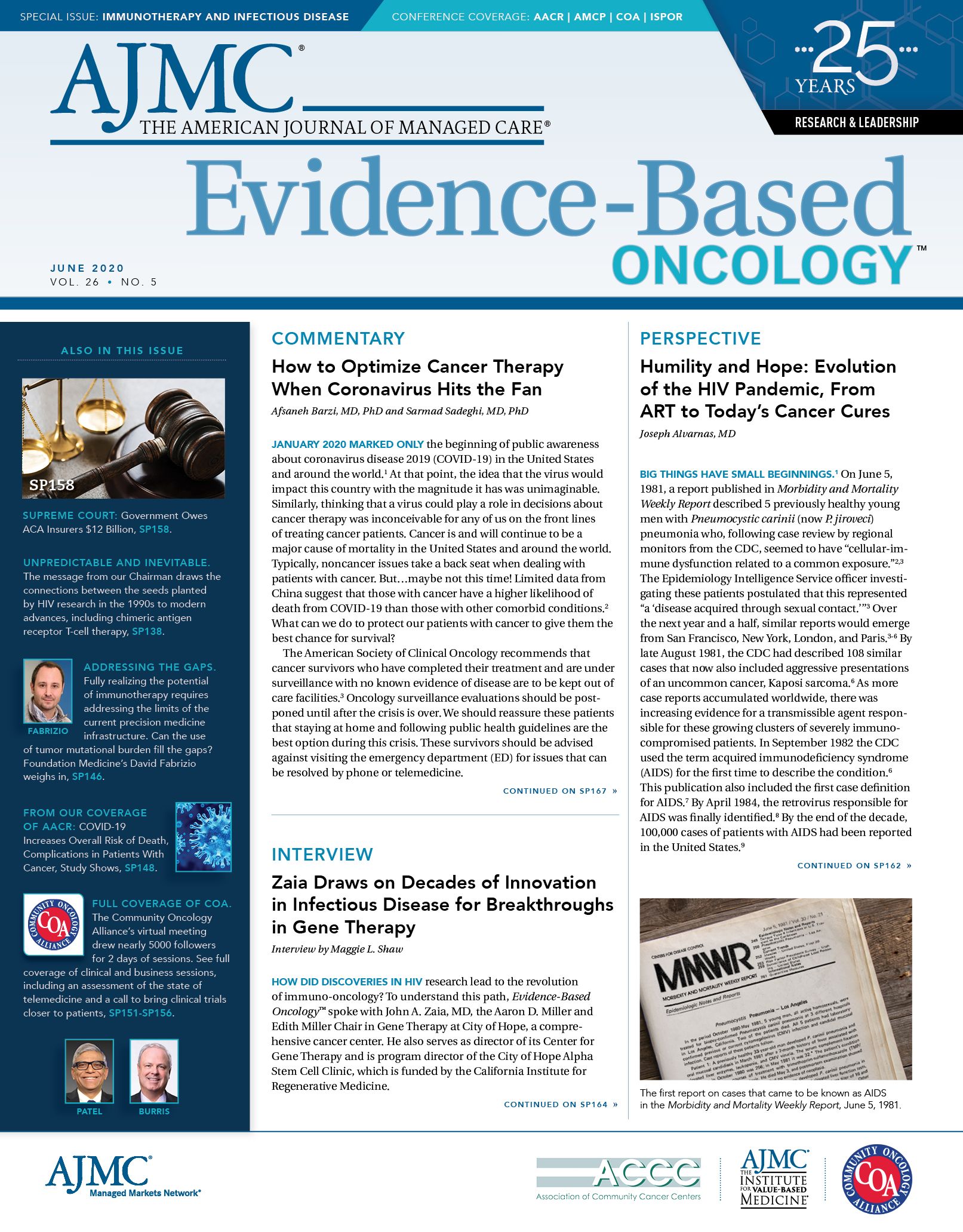- Center on Health Equity & Access
- Clinical
- Health Care Cost
- Health Care Delivery
- Insurance
- Policy
- Technology
- Value-Based Care
References for Humility and Hope, Alvarnas
References: Humility and Hope: Evolution of the HIV Pandemic, From ART to Today’s Cancer Cures
https://doi.org/10.37765/ajmc.2020.435631. Lawrence TE (story). Bolt R, Wilson M (screenplay). Lawrence of Arabia [film]. United Kingdom: Horizon Pictures; 1962. imdb.com/title/tt0056172/?ref_=fn_al_tt_1
2. CDC. Pneumocystis pneumonia — Los Angeles. MMWR Morb Mortal Wkly Rep. 1981;30(21):250-252.
3. CDC. First report of AIDS. MMWR Morb Mortal Wkly Rep. 2001;50(21):429.
4. du Bois RM, Branthwaite MA, Mikhail JR, Batten JC. Primary Pneumocystis carinii and cytomegalovirus infections. Lancet. 1981;318(8259):1339. doi:10.1016/S0140-6736(81)91353-2
5. Pickrell J. Timeline: HIV and AIDS. New Scientist. September 4, 2006. Accessed May 19, 2020. newscientist.com/article/dn9949-timeline-hivand-aids/
6. A timeline of HIV and AIDS. HIV.gov. Accessed May 19, 2020. hiv.gov/federal-response/ending-the-hiv-epidemic/overview/endingepidemic-timeline
7. CDC. Current trends update on Acquired Immune Deficiency Syndrome (AIDS)—United States. MMWR Morb Mortal Wkly Rep. 1982;31(37):507-508, 513-514. https://www.cdc.gov/mmwr/preview/mmwrhtml/00001163.htm
8. Altman LK. New U.S. report names virus that may cause AIDS. The New York Times. April 24, 1984. Accessed May 19, 2020. nytimes.com/1984/04/24/science/new-us-report-names-virus-that-may-causeaids.html
9. History of HIV and AIDS overview. Avert. Updated October 10, 2019. Accessed May 23, 2020. avert.org/professionals/history-hiv-aids/overview
10. Sharp P, Hahn BH. The evolution of HIV-1 and the origin of AIDS. Philos Trans R Soc Lond B Biol Sci. 2010;365(1552):2487-2494. doi:10.1098/rstb.2010.0031
11. Fehervari Z. Origin story. Nature Research. November 28, 2018. Accessed May 23, 2020. https://nature.com/articles/d42859-018-00008-6
12. CNN. Researchers trace first HIV case to 1959 in the Belgian Congo. CNN Interactive. February 3, 1998. Accessed May 23, 2020. cnn.com/HEALTH/9802/03/earliest.aids/
13. Sharp P, Hahn BH. Origins of HIV and the AIDS pandemic. Cold Spring Harb Perspect Med. 2011;1(1):a006841. doi:10.1101/cshperspect.a006841
14. Hendrix S. A mystery illness killed a boy in 1969. years later, doctors believed they’d learned what it was: AIDS. The Washington Post. May 15, 2019. Accessed May 23, 2020. washingtonpost.com/history/2019/05/15/mystery-illness-killed-boy-years-later-doctorslearned-what-it-was-aids/
15. Global Health Observatory (GHO) data: HIV/AIDS. World Health Organization. Accessed May 23, 2020. who.int/gho/hiv/en/
16. CDC. Update: trends in AIDS incidence — United States, 1996. MMWR Morb Mortal Wkly Rep. 1997;46(37);861-867.
17. Mellors JW, Rinaldo CR, Gupta P, et al. Prognosis in HIV-1 infection predicted by the quantity of virus in plasma. Science. 1996;272(5265):1167-1170. doi:10.1126/science.272.5265.1167
18. Feinberg MB. Changing the natural history of HIV disease. Lancet. 1996;348(9022):239-246. doi:10.1016/s0140-6736(96)06231-9
19. Vella S. XI International AIDS Conference: new antiretroviral therapy guidelines. NEJM Journal Watch. October 1, 1996. Accessed May 19,
2020. jwatch.org/ac199610010000002/1996/10/01/xi-international-aids-conference-new
20. Scaccia A, Madell R. Facts about HIV: life expectancy and long-term outlook. Healthline. Reviewed April 27, 2018. Accessed May 23, 2020. healthline.com/health/hiv-aids/life-expectancy
21. HIV mortality slide series through 2015. CDC Stacks Public Health Publications. August 13, 2018. Accessed May 23, 2020. https://stacks.cdc.gov/view/cdc/58351
22. AIDS drugs have saved 3 million years of life in the United States. News release. National Institute of Allergy and Infectious Diseases; June 2,
2006. Accessed May 23, 2020. nih.gov/news-events/news-releases/aidsdrugs-have-saved-3-million-years-life-united-states
23. Hutter G, Nowak D, Mossner M, et al. Long-term control of HIV by CCR5 Delta32/Delta32 stem-cell transplantation. N Engl J Med.
2009;360(7):692-698. doi:10.1056/NEJMoa0802905
24. Mandavilli A. The ‘London Patient,’ cured of HIV, reveals his identity. The New York Times. Published March 9, 2020. Accessed May 23, 2020. nytimes.com/2020/03/09/health/hiv-aids-london-patient-castillejo.html
25. Bavinton BR, Rodger AJ. Undetectable viral load and HIV transmission dynamics on an individual and population level: where next in the
global HIV response? Curr Opin Infect Dis. 2020;33(1):20-27. doi:10.1097/QCO.0000000000000613
26. Reitsema M, van Hoek AJ, van der Loeff MS, et al. Preexposure prophylaxis for men who have sex with men in the Netherlands: impact on HIV and Neisseria gonorrhoeae transmission and cost-effectiveness. AIDS. 2020;34(4):621-630. doi:10.1097/QAD.0000000000002469
27. Selik RM, Mokotoff ED, Branson B, et al. Revised surveillance case definition for HIV infection — United States, 2014. MMWR Morb Mortal Wkly Rep. 2014;63(RR03):1-10. cdc.gov/mmwr/preview/mmwrhtml/rr6303a1.htm
28. Grogg KL, Miller RF, Dogan A. HIV infection and lymphoma. J Clin Pathol. 2007;60(12):1365-1372. doi:10.1136/jcp.2007.051953
29. Achenbach CJ, Buchanan AL, Cole SR, et al; Centers for AIDS Research (CFAR) Network of Integrated Clinical Systems (CNICS). HIV viremia and incidence of non-Hodgkin lymphoma in patients successfully treated with antiretroviral therapy. Clin Infect Dis. 2014;58(11):1599-1606. doi:10.1093/cid/ciu076
30. Levine AM. Acquired immunodeficiency syndrome—related lymphoma. Blood. 1992;80(1):8-20.
31. Vishnu P, Aboulafia DM. AIDS-related non-Hodgkin’s lymphoma in the era of highly active antiretroviral therapy. Adv Hematol. 2012;2012:485943. doi:10.1155/2012/485943
32. Swiss HIV Cohort Study; Schoeni-Affolter F, Ledergerber B, Rickenbach M, et al. Cohort profile: the Swiss HIV Cohort Study. Int J Epidemiol. 2010;39(5):1179-1189. doi:10.1093/ije/dyp321
33. Clifford GM, Polesel J, Rickenbach M, et al; Swiss HIV Cohort Study. Cancer risk in the Swiss HIV Cohort Study: associations with immunodeficiency, smoking, and highly active antiretroviral therapy. J Natl Cancer Inst. 2005;97(6):425-432. doi:10.1093/jnci/dji072
34. Hamilton-Dutoit SJ, Pallesen G, Franzmann MB, et al. AIDS-related lymphoma. histopathology, immunophenotype, and association with Epstein-Barr virus as demonstrated by in situ nucleic acid hybridization. Am J Pathol. 1991;138(1):149-163.
35. Kaplan LD, Straus DJ, Testa MA, et al. Low-dose compared with standard-dose m-BACOD chemotherapy for non-Hodgkin’s lymphoma associated with human immunodeficiency virus infection. National Institute of Allergy and Infectious Diseases AIDS Clinical Trials Group. N Engl J Med. 1997;336(23):1641-1648. doi:10.1056/NEJM199706053362304
36. Boué F, Gabarre J, Gisselbrecht C, et al. Phase II trials of CHOP plus rituximab in patients with HIV-associated non-Hodgkin’s lymphoma. J Clin Oncol. 2006;24(25):4123-4128. doi:10.1200/JCO.2005.05.4684
37. Kaplan LD, Lee JY, Ambinder RF, et al. Rituximab does not improve clinical outcome in a randomized phase 3 trial of CHOP with or without rituximab in patients with HIV-associated non-Hodgkin lymphoma: AIDS-Malignancies Consortium Trial 010. Blood. 2005;106(5):1538-1543. doi:10.1182/blood-2005-04-1437
38. Little RF, Pittaluga S, Grant N, et al. Highly effective treatment of acquired immunodeficiency syndrome—related lymphoma with dose-adjusted EPOCH: impact of antiretroviral suspension and tumor biology. Blood. 2003;101(12):4653-4659. doi:10.1182/blood-2002-11-3589
39. Sparano JA, Lee JY, Kaplan LD, et al; AIDS Malignancy Consortium. Rituximab plus concurrent infusional EPOCH chemotherapy is highly effective in HIV-associated B-cell non-Hodgkin lymphoma. Blood. 2010;115(15):3008-2016. doi:10.1182/blood-2009-08-231613
40. Dunleavy K, Little RF, Pittaluga S, et al. The role of tumor histogenesis, FDG-PET, and short-course EPOCH with dose-dense rituximab (SCEPOCH-RR) in HIV-associated diffuse large B-cell lymphoma. Blood. 2010;115(15):3017-3024. doi:10.1182/blood-2009-11-253039
41. Noy A, Kaplan L, Lee JY. A modified dose intensive R- CODOX-M/IVAC for HIV-associated Burkitt lymphoma and atypical Burkitt lymphoma (BL) demonstrates high cure rates and low toxicity: prospective multicenter trial of the AIDS Malignancy Consortium (AMC 048). Blood. 2013;122(21):639. doi:10.1182/blood.V122.21.639.639
42. Rodrigo JA, Hicks LK, Cheung MC, et al. HIV-associated Burkitt lymphoma: good efficacy and tolerance of intensive chemotherapy including CODOX-M/IVAC with or without rituximab in the HAART era. Adv Hematol. 2012;2012:735392. doi:10.1155/2012/735392
43. Montoto S, Wilson J, Shaw K, et al. Excellent immunological recovery following CODOX-M/IVAC, an effective intensive chemotherapy for HIV-associated Burkitt’s lymphoma. AIDS. 2010;24(6):851-856. doi:10.1097/QAD.0b013e3283301578
44. Cortes J, Thomas D, Rios A, et al. Hyperfractionated cyclophosphamide, vincristine, doxorubicin, and dexamethasone and highly active antiretroviral therapy for patients with acquired immunodeficiency syndrome—related Burkitt lymphoma/leukemia. Cancer. 2002;94(5):1492-1499.
doi:10.1002/cncr.10365
45. Kojima Y, Hagiwara S, Uehira T, et al. Clinical outcomes of AIDS-related Burkitt lymphoma: a multi-institution retrospective survey in Japan. Jpn J Clin Oncol. 2014;44(4):318-323. doi:10.1093/jjco/hyu012
46. Dunleavy K, Pittaluga S, Shovlin M, et al. Low-intensity therapy in adults with Burkitt’s lymphoma. N Engl J Med. 2013;369(20):1915-1925. doi:10.1056/NEJMoa1308392
47. Barta SK, Xue X, Wang D, et al. Treatment factors affecting outcomes in HIV-associate non-Hodgkin lymphomas: a pooled analysis of 1546 patients. Blood. 2013;122(19):3251-3262. doi:10.1182/blood-2013-04-498964
48. Alvarnas JC, Le Rademacher J, Wang Y, et al. Autologous hematopoietic cell transplantation for HIV-related lymphoma: results of the BMT CTN 0803/AMC 071 trial. Blood. 2016;128(8):1050-1058. doi:10.1182/blood-2015-08-664706
49. Ambinder RF, Wu J, Logan B, et al. Allogeneic hematopoietic cell transplant for HIV patients with hematologic malignancies: the BMT CTN-0903/AMC-080 Trial. Biol Blood Marrow Transplant. 2019;25(11):2160-2166. doi:10.1016/j.bbmt.2019.06.033
50. Alvarnas JC, Zaia JA, Forman SJ. How I treat patients with HIV-related hematological malignancies using hematopoietic cell transplantation. Blood. 2017;130(18):1976-1984. doi:10.1182/blood-2017-04-551606
51. Division of HIV/AIDS Prevention. Statistic overview. CDC. Updated May 18, 2020. Accessed May 23, 2020. cdc.gov/hiv/statistics/overview/index.html
52. Overbaugh J, Morris L. The antibody response against HIV-1. Cold Spring Harb Perspect Med. 2012;2(1):a007039. doi:10.1101/cshperspect.a007039
53. Deng K, Pertea M, Rongvaux A, et al. Broad CTL response is required to clear latent HIV-1 due to dominance of escape mutations. Nature.
2015;517(7534):381-385. doi:10.1038/nature14053
54. Harris JE. Why we don’t have an HIV vaccine, and how we can develop one. Health Aff (Millwood). 2009;28(6):1642-1654. doi:10.1377/hlthaff.28.6.1642
55. HHS. HIV/AIDS glossary: life cycle. AIDSinfo. Accessed May 23, 2020. aidsinfo.nih.gov/understanding-hiv-aids/glossary/1596/life-cycle
56. Milone MC, O’Doherty U. Clinical use of lentiviral vectors. Leukemia. 2018;32(7):1529-1541. doi:10.1038/s41375-018-0106-0
57. Vink CA, Counsell JR, Perocheau DP, et al. Eliminating HIV-1 packaging sequences from lentiviral vector proviruses enhances safety and expedites gene transfer for gene therapy. Mol Ther. 2017;25(8):1790-1804. doi:10.1016/j.ymthe.2017.04.028
58. Poorebrahim M, Sadeghi S, Fakhr E, et al. Production of CAR T-cells by GMP-grade lentiviral vectors: latest advances and future prospects. Crit Rev Clin Lab Sci. 2019;56(6):393-419. doi:10.1080/10408363.2019.1633512
59. Kootstra NA, Matsumura R, Verma IM. 248. gene therapy for hemophilia A using lentiviral vectors. Mol Ther. 2002;5(5):S82. doi:10.1016/S1525-
0016(16)43078-9
60. Learn more. National AIDS Memorial. aidsmemorial.org/theaidsquilt-learnmore/ Accessed May 23, 2020.

Integrated Care for Chronic Conditions: A Randomized Care Management Trial
December 3rd 2025The authors sought to understand the differential impact of payer-led community-based care management approaches on stakeholder-oriented outcomes for publicly insured adults with multiple chronic conditions.
Read More
Managed Care Reflections: A Q&A With A. Mark Fendrick, MD, and Michael E. Chernew, PhD
December 2nd 2025To mark the 30th anniversary of The American Journal of Managed Care (AJMC), each issue in 2025 includes a special feature: reflections from a thought leader on what has changed—and what has not—over the past 3 decades and what’s next for managed care. The December issue features a conversation with AJMC Co–Editors in Chief A. Mark Fendrick, MD, director of the Center for Value-Based Insurance Design and a professor at the University of Michigan in Ann Arbor; and Michael E. Chernew, PhD, the Leonard D. Schaeffer Professor of Health Care Policy and the director of the Healthcare Markets and Regulation Lab at Harvard Medical School in Boston, Massachusetts.
Read More

